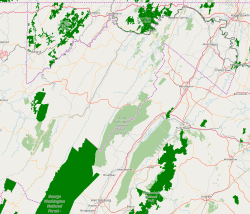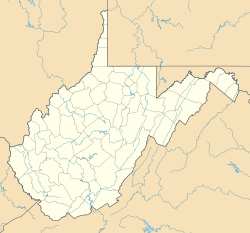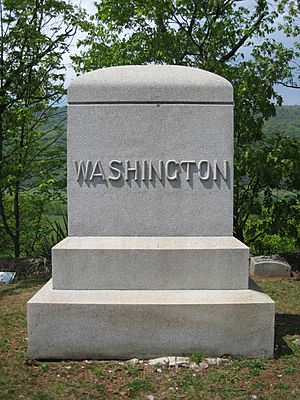Washington Bottom Farm facts for kids
Quick facts for kids |
|
|
Ridgedale
|
|
 |
|
| Area | 251.6 acres (101.8 ha) |
|---|---|
| Built | 1835 |
| Architectural style | Greek Revival |
| NRHP reference No. | 01001328 |
| Added to NRHP | November 29, 2001 |
Ridgedale (also known as Washington Bottom Farm) is a historic house and farm in West Virginia. It was built in 1835 and is a great example of Greek Revival style. This means it looks like ancient Greek buildings with grand columns and simple, strong shapes.
The farm sits on a high piece of land overlooking the South Branch Potomac River. It is located north of Romney. The area around the farm is even called Ridgedale. You can reach the farm from West Virginia Route 28 by taking Washington Bottom Road.
Ridgedale was once the home of George William Washington. He was a "gentleman farmer," meaning he owned and managed his farm. George William Washington was a descendant of Reverend Lawrence Washington, who was the great-great-grandfather of the first U.S. President, George Washington. Today, Ridgedale is a private home.
Contents
Exploring Ridgedale's Architecture
The main house at Ridgedale is a beautiful example of Greek Revival style. It is a three-story brick house with an L-shape. The roof is sloped (a hip roof) and has a small tower called a cupola in the center. This cupola has windows and a small walkway around it, known as a widow's walk.
Outside the House
The house has five chimneys on the roof. One is at each corner, and one is on the back part of the house. The front of the house has a wooden porch with steps. The main entrance has a special wide trim above it, which is typical of Greek Revival style.
The windows on the first floor are very tall. They reach almost to the floor in the front rooms. The second-floor windows are a bit smaller. The third floor has unique, small, diamond-shaped windows.
On the west side, the house is divided into two parts. The back part, called an "ell," is set back a bit. It has a kitchen porch on the first floor. There's also a door that leads to the basement.
The east side of the house also has a small porch. This porch matches the one on the front. The back part of the east side has a two-story porch. These porches were enclosed with glass windows in the 1940s. They were updated again in 2010.
Inside the House
The inside of Ridgedale is still very original. It has beautiful wooden floors and wide wooden trim. The main hallway is wide and has curved stairs. The ceilings on the first floor are very high, about 12 feet!
The second floor has slightly lower ceilings, about 11 feet. The bedrooms on this floor have small closets that were added later. The doorways on this floor have small windows above them called transoms. Two bathrooms were also added here.
The third floor has 9-foot ceilings that are angled. The small diamond-shaped windows let in light. A narrow stairway leads up to the cupola. From there, you can step out onto the widow's walk. Another stairway connects to the second-floor porch.
Ridgedale's Rich History
The land where Ridgedale Farm stands has a long history. It was first surveyed around 1749 by George Washington himself. The area was settled by Peter Peters in 1725.
Fort Williams: A Settler's Stronghold
A fort called Fort Williams was built on this land in 1756. Richard Williams built it after he escaped from Native American captivity. It was a fort for settlers, but soldiers were sometimes stationed there during the French and Indian War. Even George Washington ordered troops to help protect settler forts like this one. Today, no remains of the fort have been found, but old documents confirm it was there.
George W. Washington and His Family
George W. Washington (1809–1876) was a well-respected gentleman farmer. He was born in Virginia and was related to the famous George Washington. In 1830, he married Sarah (Sally) A. Wright. Sarah's grandfather, Major Robert Lockhart, left her and her siblings the Ridgedale land. George and Sarah took ownership after they married.
Building Ridgedale Farm
George and Sarah moved to the Ridgedale land. They first lived in a small log cabin built around 1832. As their family grew, they built the large Greek Revival main house in 1835. They had 11 children in total. Sadly, some of their children died young. One son, John, died during the American Civil War. His brother Edward also fought in the war.
George W. Washington was a successful farmer. He raised beef cattle, sheep, and pigs. He also owned many horses, some bought from England. He grew crops like corn, hay, soybeans, oats, wheat, and flax. He sold cured pork, corn, wool, and vegetables. The oldest farm building still standing was built around 1850.
George W. Washington kept a daily journal from 1832 to 1876. This journal gives us a peek into what life was like on the farm. He wrote about his sheep, buying and selling cattle and horses, and using oxen and mules for work. He even wrote about chopping ice from the river in January 1868 to store it in the icehouse.
The land behind the house, over 200 acres, was used for hay and corn. The field in front was called "the little meadow." He also used a nearby ridge to let his cattle and sheep graze. There was even an island in the South Branch Potomac River where he grew corn.
Life for Enslaved People
Like many large farms in the South at that time, Ridgedale relied on the labor of enslaved people. In 1850, the Washington family had 16 enslaved people, and by 1860, that number grew to 20. George W. Washington had inherited seven enslaved people from his father's will.
After the Civil War, many formerly enslaved people built new lives. William Bias, who had been enslaved by the Washington family, and his wife Ann, took the surname Washington. They bought land and built their home, Washington Place. This was one of the first homes in Hampshire County built by freed African Americans. William Washington later became the first African-American land developer in West Virginia. He created a neighborhood called "Blacks Hill" in Romney.
The American Civil War at Ridgedale
Ridgedale was a busy place during the American Civil War. Soldiers from the Confederate side even camped in the yard, calling it "Camp Washington." The Washington family sometimes hid Confederate soldiers in their house.
"Camp Washington" and General Ashby
In the summer of 1861, Confederate General Turner Ashby and his troops were stationed near Ridgedale. Family stories say that General Ashby used Ridgedale as his headquarters. He named it "Camp Washington" to honor George W. Washington.
General Ashby's brother, Captain Richard Ashby, was badly wounded in a battle. He was brought to the Washington home at Ridgedale. He was cared for in a room near the ballroom. Captain Ashby died there on July 3, 1861. He was first buried in Indian Mound Cemetery in Romney. Later, his body was moved to be buried with his brother in Winchester, Virginia.
George W. Washington's journal gives us important details about the Civil War in Hampshire County. His sons, Edward and John, joined the Confederate army. John was killed in battle. Edward was wounded but continued to serve as a messenger for famous generals like Stonewall Jackson. Edward also helped capture Union generals later in the war.
Two of Edward's sisters, Rebecca and Etta, even rode horses to deliver a secret message to General Jackson. They carried the message under their saddles. They told him that Union forces had taken control of Romney.
Supporting the Southern Methodists
George W. Washington was a strong supporter of the Southern Methodists. This church group had split from the main Methodist church in 1846. He helped buy land in Springfield to build a church for them. His journal mentions that his family could not attend the church for a while after the Civil War because it was being repaired.
Robert M. Washington Takes Over
George W. Washington died in 1876, and his wife Sally died in 1886. They are both buried in Indian Mound Cemetery in Romney. Their son, Robert, bought the farm from his siblings in 1879. Robert owned the farm until he died in 1930. In 1936, about 500 acres of the farm were sold to the Brinker brothers.
The Railroad Arrives
The Baltimore and Ohio Railroad built a train line near the farm in 1883. This line connected many communities. The railroad even had a special side track on the farm. This allowed them to drop off supplies like fencing. This side track was used until 1930. Today, the South Branch Valley Railroad still uses this old line near Washington Bottom Farm.
The Brinker Family Era
The Brinker brothers, Fred, George, and Joseph, bought the farm. They used to own a machinery business. In 1940, they turned the old horse barn into a dairy barn. They started a dairy business.
In 1943, Fred's son Charles W. and his wife Dorothy moved to the farm. They helped run the dairy. In 1950, they bought half of the farm. After Fred Brinker's accidental death, they bought the rest of the farm from the family. Charles and Dorothy Brinker lived at the farm for 50 years. They ran the dairy with their four children.
Later, Robert C. Brinker, Charles's son, and his wife Loretta owned the farm. They expanded the dairy in 2001. They installed a new milking parlor for 400 Holstein cattle. They grew corn and hay to feed the cows. This dairy business continued until 2003. That's when Carol and Mike Shaw bought the farm.
The farm used to be 700 acres, but now it is about 321 acres. Since the Shaws bought Ridgedale, they have worked hard to restore it. They received funding from West Virginia and the National Park Service. The Shaws live in the home and sometimes give tours if you ask.
Archaeology at Ridgedale
There is a small Indian mound located to the east of the house. This mound is an archaeological site.





